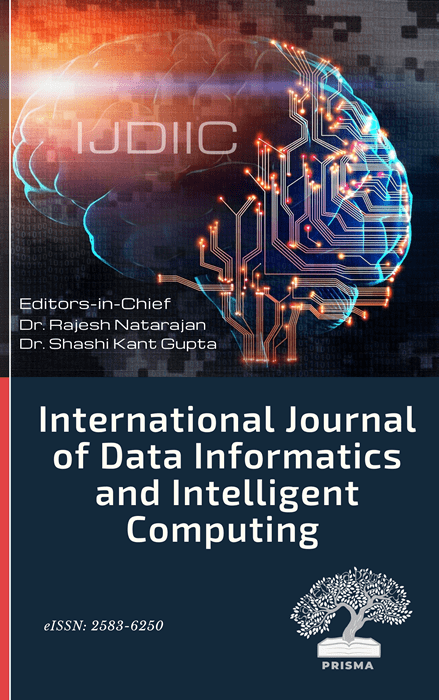Gaussian Proximal Hough Transformative Regularized Incremental Extreme Learning Machines for Palmprint Detection
DOI:
https://doi.org/10.59461/ijdiic.v3i1.95Abstract
Palmprint detection is employed for identifying individuals based on the unique patterns present on the surface of their palms. Palmprint detection aims to be used in biometric authentication systems for security applications such as access control, forensic identification, and identity verification. Several research works have been developed for palmprint detection but have faced relative difficulty achieving higher accuracy. In this paper, Gaussian Proximal Hough Transformative Regularized Incremental Extreme Learning (GPHTRIEL) is developed with higher accuracy. First, palm images are collected from the dataset. Preprocessed images are provided as input to Outlier Regularized Incremental Extreme Learning Machines, consisting of three types of layers. The input layer receives preprocessed palm images. The first hidden layer performs image segmentation. Next, a set of geometric features is extracted in the second hidden layer and sent to the third hidden layer. Finally, feature matching is performed using the Sokal–Sneath similarity index function. With this, the outlier robust function correctly detects palmprints with a minimum error. An experiment is carried out with different factors. The analyzed research results indicate that the GPHTRIEL technique achieves improved performance in 6% accuracy, 11% sensitivity, and 10% specificity and minimizes 14% computation time compared to conventional methods.
Downloads
References
S. Zhao and B. Zhang, “Joint Constrained Least-Square Regression With Deep Convolutional Feature for Palmprint Recognition,” IEEE Trans. Syst. Man, Cybern. Syst., vol. 52, no. 1, pp. 511–522, Jan. 2022, doi: 10.1109/TSMC.2020.3003021.
A. B. Mehmood, I. A. Taj, and M. Ghafoor, “Palmprint enhancement network (PEN) for robust identification,” Multimed. Tools Appl., vol. 83, no. 5, pp. 14449–14476, Jul. 2023, doi: 10.1007/s11042-023-16043-z.
M. Abdullah, B. Kedir, K. A. Alemayehu, and H. T. Habtemarium, “A Single Objective GA and PSO for the Multimodal Palmprint Recognition System,” Math. Probl. Eng., vol. 2023, pp. 1–14, Jan. 2023, doi: 10.1155/2023/7621550.
S. Trabelsi, D. Samai, F. Dornaika, A. Benlamoudi, K. Bensid, and A. Taleb-Ahmed, “Efficient palmprint biometric identification systems using deep learning and feature selection methods,” Neural Comput. Appl., vol. 34, no. 14, pp. 12119–12141, Jul. 2022, doi: 10.1007/s00521-022-07098-4.
L. R. Marval-Perez, K. Ito, and T. Aoki, “Phase-Based Palmprint Identification With Convolutional Sparse Coding,” IEEE Trans. Biometrics, Behav. Identity Sci., vol. 4, no. 3, pp. 424–438, Jul. 2022, doi: 10.1109/TBIOM.2022.3183568.
K. Ito et al., “HandSegNet: Hand segmentation using convolutional neural network for contactless palmprint recognition,” IET Biometrics, vol. 11, no. 2, pp. 109–123, Mar. 2022, doi: 10.1049/bme2.12058.
M. Li, H. Wang, H. Liu, and Q. Meng, “Palmprint recognition based on the line feature local tri‐directional patterns,” IET Biometrics, vol. 11, no. 6, pp. 570–580, Nov. 2022, doi: 10.1049/bme2.12085.
A. Iula and M. Micucci, “Multimodal Biometric Recognition Based on 3D Ultrasound Palmprint-Hand Geometry Fusion,” IEEE Access, vol. 10, pp. 7914–7925, 2022, doi: 10.1109/ACCESS.2022.3143433.
H. Shao and D. Zhong, “Towards Cross-Dataset Palmprint Recognition Via Joint Pixel and Feature Alignment,” IEEE Trans. Image Process., vol. 30, pp. 3764–3777, 2021, doi: 10.1109/TIP.2021.3065220.
D. Brown and K. Bradshaw, “Deep Palmprint Recognition with Alignment and Augmentation of Limited Training Samples,” SN Comput. Sci., vol. 3, no. 1, p. 11, Jan. 2022, doi: 10.1007/s42979-021-00859-3.
M. M. Ata, K. M. Elgamily, and M. A. Mohamed, “Robust features fusion utilization for supervised palmprint recognition,” Concurr. Comput. Pract. Exp., vol. 34, no. 10, May 2022, doi: 10.1002/cpe.6817.
İ. KILINÇ, Y. O. ARTAN, and E. BAŞESKİ, “A Multistep Fusion Matcher Approach for Large Scale Latent Fingerprint/Palmprint Recognition,” Turkish J. Electr. Eng. Comput. Sci., vol. 31, no. 2, pp. 412–430, Mar. 2023, doi: 10.55730/1300-0632.3992.
A. Ignat and I. Păvăloi, “Keypoint Selection Algorithm for Palmprint Recognition with SURF,” Procedia Comput. Sci., vol. 192, pp. 270–280, 2021, doi: 10.1016/j.procs.2021.08.028.
L. Wu, Y. Xu, Z. Cui, Y. Zuo, S. Zhao, and L. Fei, “Triple-Type Feature Extraction for Palmprint Recognition,” Sensors, vol. 21, no. 14, p. 4896, Jul. 2021, doi: 10.3390/s21144896.
G. Jaswal and R. C. Poonia, “Selection of optimized features for fusion of palm print and finger knuckle‐based person authentication,” Expert Syst., vol. 38, no. 1, Jan. 2021, doi: 10.1111/exsy.12523.
L. Fei, B. Zhang, Y. Xu, C. Tian, I. Rida, and D. Zhang, “Jointly Heterogeneous Palmprint Discriminant Feature Learning,” IEEE Trans. Neural Networks Learn. Syst., vol. 33, no. 9, pp. 4979–4990, Sep. 2022, doi: 10.1109/TNNLS.2021.3066381.
P. Hemrajani, V. S. Dhaka, G. Rani, P. Shukla, and D. P. Bavirisetti, “Efficient Deep Learning Based Hybrid Model to Detect Obstructive Sleep Apnea,” Sensors, vol. 23, no. 10, p. 4692, May 2023, doi: 10.3390/s23104692.
H. Shao and D. Zhong, “One-shot cross-dataset palmprint recognition via adversarial domain adaptation,” Neurocomputing, vol. 432, pp. 288–299, Apr. 2021, doi: 10.1016/j.neucom.2020.12.072.
B. Liu and J. Feng, “Palmprint orientation field recovery via attention-based generative adversarial network,” Neurocomputing, vol. 438, pp. 1–13, May 2021, doi: 10.1016/j.neucom.2021.01.049.
Y. Ma and Z. Guo, “Palmprint Translation Network for Cross-Spectral Palmprint Recognition,” Electronics, vol. 11, no. 5, p. 736, Feb. 2022, doi: 10.3390/electronics11050736.
Y. Liu and A. Kumar, “Contactless Palmprint Identification Using Deeply Learned Residual Features,” IEEE Trans. Biometrics, Behav. Identity Sci., vol. 2, no. 2, pp. 172–181, Apr. 2020, doi: 10.1109/TBIOM.2020.2967073.
M. Izadpanahkakhk, S. Razavi, M. Taghipour-Gorjikolaie, S. Zahiri, and A. Uncini, “Deep Region of Interest and Feature Extraction Models for Palmprint Verification Using Convolutional Neural Networks Transfer Learning,” Appl. Sci., vol. 8, no. 7, p. 1210, Jul. 2018, doi: 10.3390/app8071210.
K. Zhang, G. Xu, Y. K. Jin, G. Qi, X. Yang, and L. Bai, “Palmprint recognition based on gating mechanism and adaptive feature fusion,” Front. Neurorobot., vol. 17, May 2023, doi: 10.3389/fnbot.2023.1203962.
W. Jia, W. Xia, Y. Zhao, H. Min, and Y.-X. Chen, “2D and 3D Palmprint and Palm Vein Recognition Based on Neural Architecture Search,” Int. J. Autom. Comput., vol. 18, no. 3, pp. 377–409, Jun. 2021, doi: 10.1007/s11633-021-1292-1.
K. Jing, X. Zhang, and G. Song, “Correntropy-Induced Discriminative Nonnegative Sparse Coding for Robust Palmprint Recognition,” Sensors, vol. 20, no. 15, p. 4250, Jul. 2020, doi: 10.3390/s20154250.
Downloads
Published
How to Cite
Issue
Section
License
Copyright (c) 2024 N.Kohila, T.Ramprabha

This work is licensed under a Creative Commons Attribution-ShareAlike 4.0 International License.








